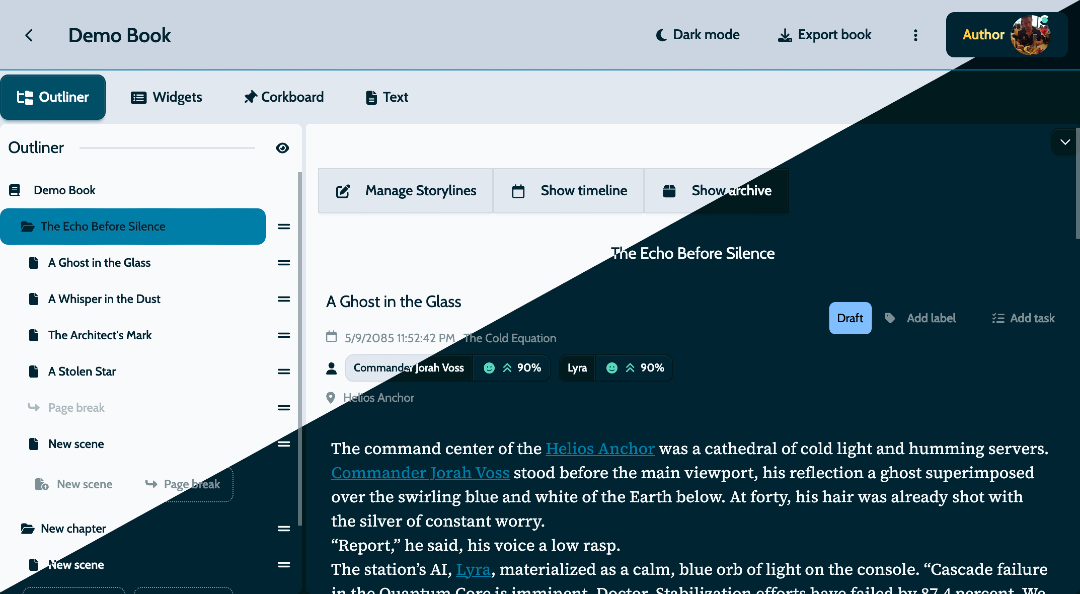MyStory.today version 1.25 is here, and this update transforms how you connect with your characters. The star feature: character moods that bring emotional depth to your storytelling.
🎭 Character Moods: Give Your Characters Emotional Range
Your characters can finally feel what your story demands. The new character moods system lets you track emotional states scene by scene, adding layers of authenticity that readers notice.
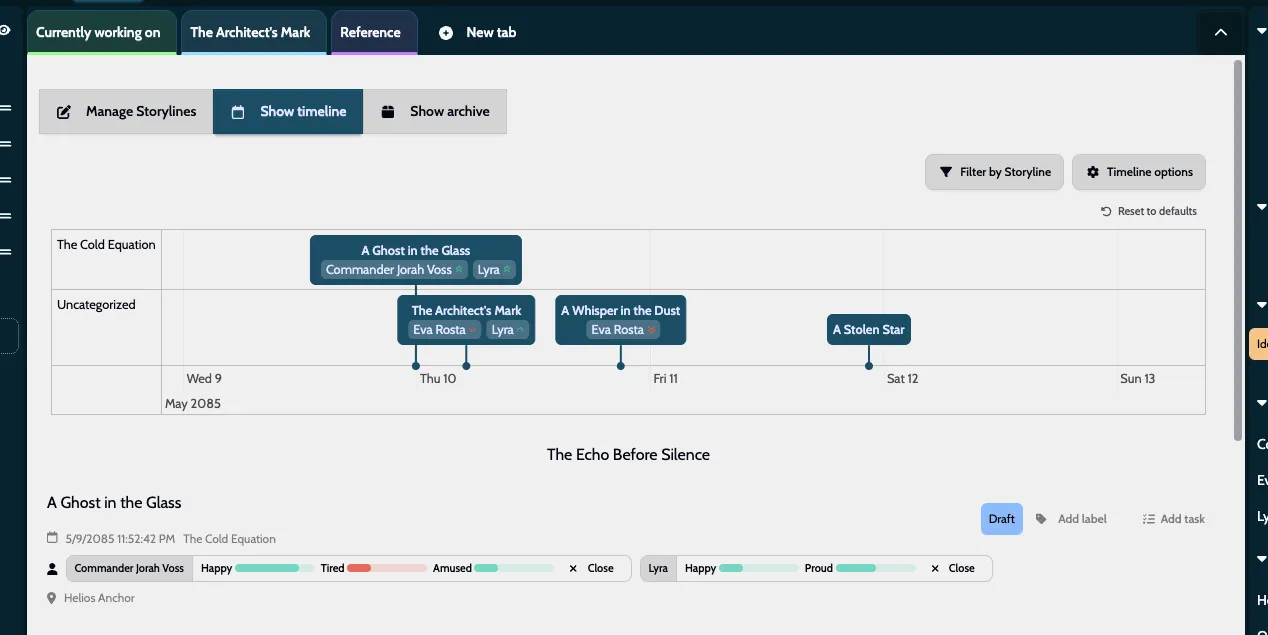
📝 Step-by-Step Workflow
Step 1: Character Assignment
The first step is to assign characters to your text. You can use the character button in the toolbar or press @ to quick-select a character or place. As you continue typing, the list filters dynamically, making it easy to find exactly who you need. This intelligent search system works even if you have dozens of characters in your story.
Step 2: Scene Character Overview
When the scene is saved, you’ll see all characters from this scene displayed above the scene content. Each character starts with a base mood (50%, neutral), providing a clean slate for emotional development. This visual overview helps you quickly identify which characters need mood assignments before moving on.
Step 3: Multi-Mood Assignment
Clicking on a character opens a comprehensive mood selection interface. Here you can assign multiple moods to each character, recognizing that emotions are rarely singular in real life. Want your protagonist to be both “hopeful” and “anxious”? No problem. The system supports complex emotional states that mirror real human experience.
Step 4: Automatic Mood Calculation
This is where the magic happens. The system automatically calculates each character’s overall mood based on the emotions you assign.
Simply explained:
- Each emotion is classified as positive, negative, or neutral
- All characters start from a neutral baseline
- The intensity of each emotion affects the overall mood
- The result shows whether your character is generally feeling positive or negative
For example, if you assign “Happy” at high intensity (70%) and slightly “Sad” (30%), your character will be predominantly positive (70%) because the positive feelings outweigh the negative ones.
Step 5: Visual Mood Display
After calculation, the mood is visible above the scene. By default, you see a clean summary that doesn’t clutter your workspace. Click to expand into a detailed breakdown showing each assigned mood, its weight, and how it contributes to the overall emotional state. This dual-view system works for both quick checks and deep analysis.
Step 6: Timeline Integration
The mood of every character is then automatically visible in the timeline. This creates a powerful chronological view of character development. You can see at a glance how your protagonist’s confidence grows across chapters, or how a villain’s desperation intensifies as the climax approaches. It’s perfect for identifying emotional arcs and ensuring consistency.
💡 Practical Example
Imagine you’re writing a dramatic confrontation scene between your protagonist Sarah and her former mentor Professor Anderson:
Scene Setup: Sarah has just discovered Anderson betrayed her research team to corporate competitors.
Character Moods Assigned
- Sarah: “Betrayed” (weight: 80%), “Determined” (weight: 60%), “Angry” (weight: 40%)
- Anderson: “Guilty” (weight: 70%), “Defensive” (weight: 50%), “Resigned” (weight: 30%)
System Calculation: Sarah’s mood score becomes 75% (neutral base 50% + negative mood modifications), while Anderson’s score is 35% (neutral base 50% + significant negative modifications).
Timeline Impact: In the timeline view, you’ll see Sarah’s emotional journey from “Trusting” → “Shocked” → “Betrayed” across three chapters, while Anderson moves from “Confident” → “Uneasy” → “Guilty.”
This emotional tracking ensures:
- Consistency: Sarah doesn’t accidentally forgive Anderson two scenes later
- Arc Development: You can plan her eventual character growth toward forgiveness
- Reader Engagement: The emotional payoff feels earned and authentic
🎯 Benefits and Use Cases
For Novel Writers
- Character Arc Planning: Map emotional journeys from introduction to resolution
- Consistency Checking: Ensure characters react appropriately to plot events
- Pacing Control: Balance high-tension emotional scenes with quieter character moments
- Motivation Tracking: Understand why characters make specific decisions at key moments
For Screenwriters
- Scene Emotional Core: Establish the emotional foundation before writing dialogue
- Character Relationship Dynamics: Track how relationships evolve through mood interactions
- Act Structure: Ensure emotional stakes escalate appropriately across three acts
- Production Notes: Provide clear emotional direction for actors and directors
For Series Authors
- Multi-Book Continuity: Maintain character personalities across installments
- Character Growth Measurement: Quantify how characters evolve over years of story time
- Fan Engagement: Create emotionally consistent characters readers can connect with deeply
- Writing Team Coordination: Keep multiple writers aligned on character emotional states
For Genre-Specific Writing
- Romance: Track attraction, conflict, and resolution emotional beats
- Mystery: Monitor suspicion, revelation, and shock emotional states
- Fantasy: Manage magical emotional transformations and character power progression
- Thriller: Maintain tension through escalating emotional stakes
This isn’t just a nice-to-have. It’s a game-changer for authors who care about emotional continuity. No more forgetting that your protagonist was supposed to be heartbroken in chapter 12.
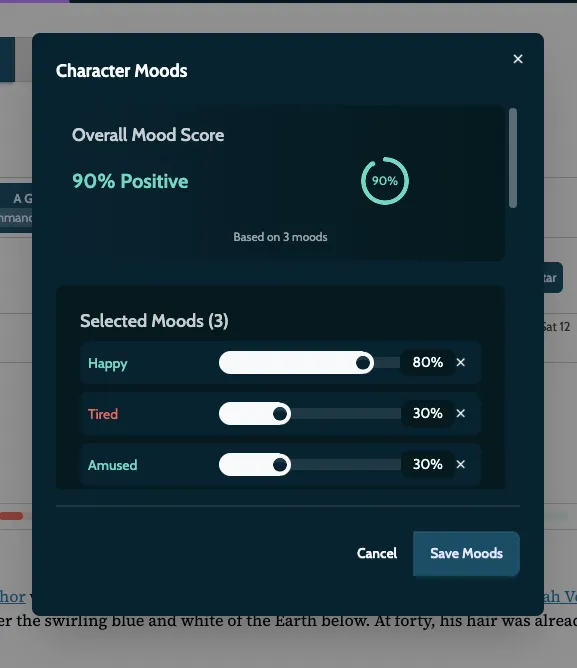
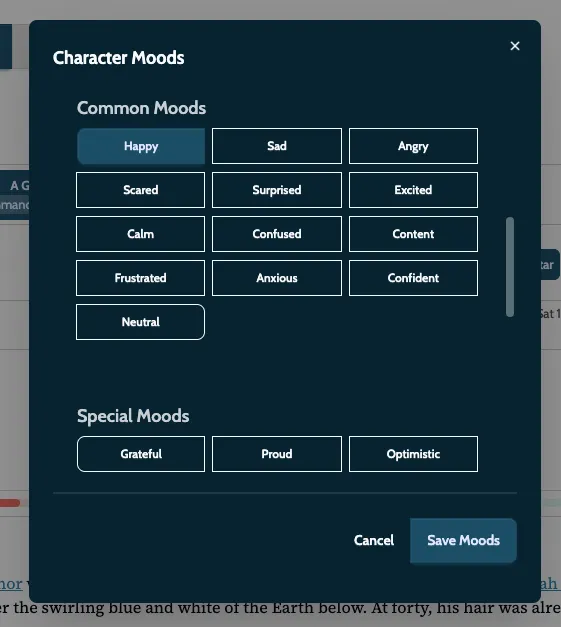
🔄 Smart App Updates: Stay Current Automatically
Missing updates because you’re deep in writing flow? We fixed that. MyStory now checks for updates in the background and notifies you when something new is available.
The system works like this:
You can even update directly from the news page while reading about new features. Smart design for writers who hate interruptions.
📰 Enhanced News Experience: Read More, Update Instantly
The news page just got serious upgrades. You can now dive deeper into updates and take action immediately without leaving the app.
What’s new:
Now you can read about new features and immediately experience them without switching contexts.
👥 Community Foundation: Connect with Fellow Authors
Collaborative writing starts with knowing who you’re working with. Version 1.25 introduces community names to lay the groundwork for future collaborative features.
What this means:
Think of this as step one toward a connected writing community. Your community name becomes your identity as we build collaborative tools.

🎉 Writing Achievements: Celebrate Your Daily Victories
Hitting your daily writing targets now comes with celebration. When you reach your word count goal for the day, a confetti animation fills your screen to acknowledge your achievement.
The achievement system:
Writing is hard work. Sometimes you need that little moment of recognition to keep going tomorrow.
🎛️ Smoother UI: Better Timeline and Archive Control
We’ve made several user interface improvements based on your feedback. The timeline reset button is now impossible to miss, and archive settings work globally across your workspace.
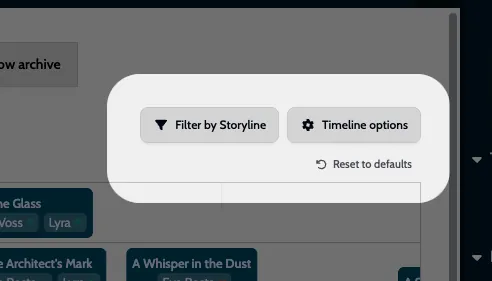
Key improvements:
Small changes that add up to significantly smoother daily use.
🌍 Translation Fixes: Better International Experience
We’ve fixed several translation issues to ensure MyStory works consistently in your preferred language. International users should now see proper translations throughout the app, with corrected web payment pages, archive module labels, and editor font dropdown displays. These improvements eliminate mixed-language interfaces, providing a consistent, native experience regardless of your language preference.
Your writing experience should feel native, regardless of your language preference.
What This Means for Your Writing
Character moods aren’t just another checkbox feature. They transform how you think about emotional continuity in your stories. You can track how characters evolve, ensure consistent reactions to plot events, and create more authentic emotional journeys for readers to follow.
The other updates all serve one purpose: getting out of your way. Automatic updates mean you never miss improvements. Better news keeps you informed. Community tools prepare you for collaboration. UI polish reduces friction. Translation fixes ensure everyone gets the same quality experience.
Looking Forward
Character moods are just the beginning of deeper storytelling tools we’re building. The community foundation sets the stage for collaborative features that will transform how you work with other writers.
Your feedback continues to shape our roadmap. Keep telling us what’s working, what’s frustrating, and what would make your writing life better.
Get Started
Update to version 1.25 and give your characters emotional depth. Set moods that track your story’s emotional arc, celebrate your writing victories, and enjoy a smoother writing experience.
Your stories deserve characters that feel real.


